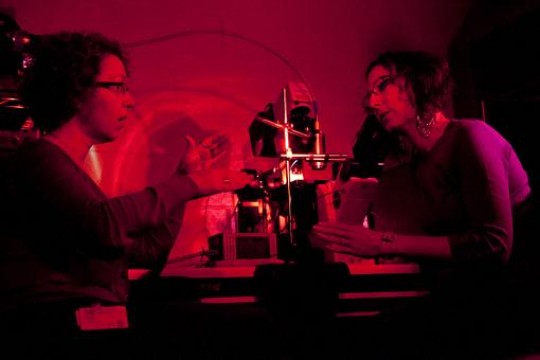Skin ‘sees’ UV light, starts producing pigment
Skin ‘sees’ UV light, starts producing pigment
In a new study, biologists report that melanocyte skin cells detect ultraviolet light using a photosensitive receptor previously thought to exist only in the eye. This eye-like ability of skin to sense light triggers the production of melanin within hours, more quickly than previously thought, in an apparent rush to protect against damage to DNA.
The eyes have it (so does the skin). Elena Oancea, left, and Nadine Wicks discovered that skin cells contain rhodopsin, a photosensitive receptor used by the eye to detect light. It’s part of human skin’s self-defense against damage to DNA. Credit: Mike Cohea/Brown University
PROVIDENCE, R.I. [Brown University] — For most people, tanning seems a simple proposition. A naturally light-skinned person lies in the sun for hours and ends up as bronzed as a Jersey Shore star. To scientists, the reaction of skin to ultraviolet light is more mysterious. A new study demonstrates that skin detects UVA radiation using a light-sensitive receptor previously found only in the eye and that this starts melanin production within a couple of hours. Until now, scientists only knew that melanin production occurred days after UVB radiation had already begun damaging DNA.
“As soon as you step out into the sun, your skin knows that it is exposed to UV radiation,” said senior author Elena Oancea, assistant professor of biology in the Department of Molecular Pharmacology, Physiology, and Biotechnology at Brown University. “This is a very fast process, faster than anything that was known before.”

Scientists believe that melanin protects the DNA in skin cells against damage from UVB rays by absorbing the incoming radiation. It isn’t perfect, which is why people must use sun block. But the new study in the journal Current Biology shows that the body mounts its defense much sooner, well before it becomes apparent in the form of a tan.
In lab experiments with human melanin-producing skin cells called melanocytes, Oancea, graduate student Nadine Wicks, and their team discovered that the cells contain rhodopsin, a photosensitive receptor used by the eye to detect light. Moreover, they traced the steps of how rhodopsin unleashes calcium ion signals that instigate melanin production.
Eyes on the skin
In the team’s first experiment, the scientists were looking to see whether UV light instigated a calcium signaling response. They found nothing. But guessing that the skin might sense light like the eyes do, they added retinal, a co-factor of opsin receptors including rhodopsin.
“When we did that, we saw an immediate and massive calcium response,” said Wicks, the study’s lead author.
Further investigations found that the cells contained rhodopsin RNA and protein. Under UV light, when the scientists reduced rhodopsin levels in the cells, calcium signaling was reduced. Later, when they starved cells of retinal, they found that melanin production dropped. The authors also determined that long-wavelength UVA light, rather than short-wavelength UVB light, is what stimulates rhodopsin in melanocytes.
 A healthy glow. Human melanocyte skin cells fluoresce as their calcium signaling spikes after exposure to ultraviolet light and retinal, a key step in producing melanin. This led researchers to discover rhodopsin receptors in skin, which detect UVA light.
A healthy glow. Human melanocyte skin cells fluoresce as their calcium signaling spikes after exposure to ultraviolet light and retinal, a key step in producing melanin. This led researchers to discover rhodopsin receptors in skin, which detect UVA light.
During several experiments they were able to trace the following process: When UVA light strikes rhodopsin receptors with retinal, calcium signals are triggered within a few seconds. After an hour, measurable amounts of melanin accumulate, although in relatively small quantities compared to the production that will occur within 24 hours.
As much as they learned, Oancea and Wicks still have some questions. One is whether rhodopsin is acting alone or in concert with another yet undiscovered receptor. Another question is whether melanocytes immediately begin exporting melanin to other kinds of skin cells for protection or whether they keep the early supply for themselves.
Just because scientists are learning more about how the skin responds to and protects itself against UV radiation, Oancea said, that’s no reason for people to change what they do to protect themselves.
“This doesn’t say, ‘Don’t use sunscreen’,” Oancea said.
In addition to Oancea and Wicks, other authors were Jason Chan, Julia Najera, and Jonathan Ciriello.
Brown University, the National Institutes of Health, and the Natural Sciences and Engineering Research Council of Canada supported the research.
###
* The above story is adapted from materials provided by Brown University
** More information at Brown University (Providence, Rhode Island, USA)




















